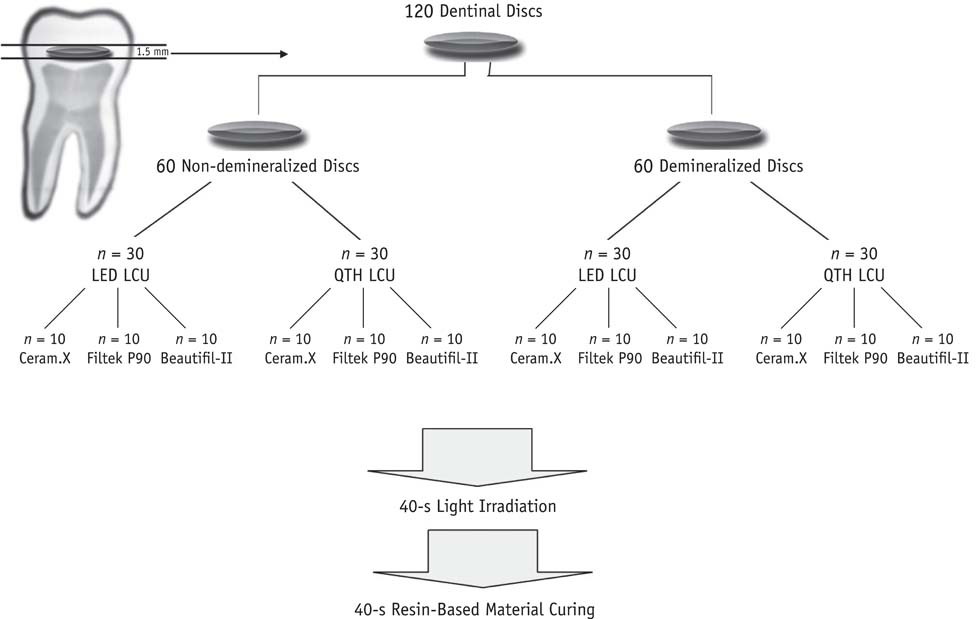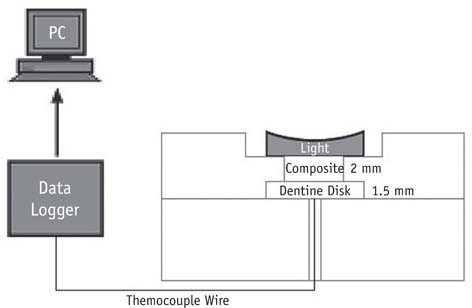Restor Dent Endod.
2014 Aug;39(3):155-163.
Temperature changes under demineralized dentin during polymerization of three resin-based restorative materials using QTH and LED units
- Affiliations
-
- 1Torabinejad Dental Research Center and Department of Operative Dentistry, School of Dentistry, Isfahan University of Medical Sciences, Isfahan, Iran.
- 2Dental Materials Research Center and Department of Operative Dentistry, School of Dentistry, Isfahan University of Medical Sciences, Isfahan, Iran. khoroushi@dnt.mui.ac.ir
- 3Department of Operative Dentistry, School of Dentistry, Isfahan University of Medical Sciences, Isfahan, Iran.
- 4Iran Polymer and Petrochemical Institute, Tehran, Iran.
Abstract
OBJECTIVES
Light-curing of resin-based materials (RBMs) increases the pulp chamber temperature, with detrimental effects on the vital pulp. This in vitro study compared the temperature rise under demineralized human tooth dentin during light-curing and the degrees of conversion (DCs) of three different RBMs using quartz tungsten halogen (QTH) and light-emitting diode (LED) units (LCUs).
MATERIALS AND METHODS
Demineralized and non-demineralized dentin disks were prepared from 120 extracted human mandibular molars. The temperature rise under the dentin disks (n = 12) during the light-curing of three RBMs, i.e. an Ormocer-based composite resin (Ceram. X, Dentsply DeTrey), a low-shrinkage silorane-based composite (Filtek P90, 3M ESPE), and a giomer (Beautifil II, Shofu GmbH), was measured with a K-type thermocouple wire. The DCs of the materials were investigated using Fourier transform infrared spectroscopy.
RESULTS
The temperature rise under the demineralized dentin disks was higher than that under the non-demineralized dentin disks during the polymerization of all restorative materials (p < 0.05). Filtek P90 induced higher temperature rise during polymerization than Ceram.X and Beautifil II under demineralized dentin (p < 0.05). The temperature rise under demineralized dentin during Filtek P90 polymerization exceeded the threshold value (5.5degrees C), with no significant differences between the DCs of the test materials (p > 0.05).
CONCLUSIONS
Although there were no significant differences in the DCs, the temperature rise under demineralized dentin disks for the silorane-based composite was higher than that for dimethacrylate-based restorative materials, particularly with QTH LCU.
Keyword
MeSH Terms
Figure
Reference
-
1. Ferracane JL. Resin composite-state of the art. Dent Mater. 2011; 27:29–38.
Article2. Knezević A, Tarle Z, Meniga A, Sutalo J, Pichler G. Influence of light intensity from different curing units upon composite temperature rise. J Oral Rehabil. 2005; 32:362–367.
Article3. Zach L, Cohen G. Pulp response to externally applied heat. Oral Surg Oral Med Oral Pathol. 1965; 19:515–530.
Article4. Atai M, Motevasselian F. Temperature rise and degree of photopolymerization conversion of nanocomposites and conventional dental composites. Clin Oral Investig. 2009; 13:309–316.
Article5. Dogan A, Hubbezoglu I, Dogan OM, Bolayir G, Demir H. Temperature rise induced by various light curing units through human dentin. Dent Mater J. 2009; 28:253–260.
Article6. Yoon TH, Lee YK, Lim BS, Kim CW. Degree of polymerization of resin composites by different light sources. J Oral Rehabil. 2002; 29:1165–1173.
Article7. Bala O, Olmez A, Kalayci S. Effect of LED and halogen light curing on polymerization of resin-based composites. J Oral Rehabil. 2005; 32:134–140.
Article8. Santini A, Watterson C, Miletic V. Temperature rise within the pulp chamber during composite resin polymerisation using three different light sources. Open Dent J. 2008; 2:137–141.
Article9. Bouillaguet S, Caillot G, Forchelet J, Cattani-Lorente M, Wataha JC, Krejci I. Thermal risks from LED- and high-intensity QTH-curing units during polymerization of dental resins. J Biomed Mater Res B Appl Biomater. 2005; 72:260–267.
Article10. Mousavinasab SM, Meyers I. Comparison of depth of cure, hardness and heat generation of LED and high intensity QTH light sources. Eur J Dent. 2011; 5:299–304.
Article11. Hussey DL, Biagioni PA, Lamey PJ. Thermographic measurement of temperature change during resin composite polymerization in vivo. J Dent. 1995; 23:267–271.
Article12. Durey K, Santini A, Miletic V. Pulp chamber temperature rise during curing of resin-based composites with different light-curing units. Prim Dent Care. 2008; 15:33–38.
Article13. Ratih DN, Palamara JE, Messer HH. Temperature change, dentinal fluid flow and cuspal displacement during resin composite restoration. J Oral Rehabil. 2007; 34:693–701.
Article14. Yang B, Flaim G, Dickens SH. Remineralization of human natural caries and artificial caries-like lesions with an experimental whisker-reinforced ART composite. Acta Biomater. 2011; 7:2303–2309.
Article15. Tosun G, Usumez A, Yondem I, Sener Y. Temperature rise under normal and caries-affected primary tooth dentin disks during polymerization of adhesives and resin-containing dental materials. Dent Mater J. 2008; 27:466–470.
Article16. Fanibunda KB. Thermal conductivity of normal and abnormal human dentine. Arch Oral Biol. 1975; 20:457–459.
Article17. Chen MH. Update on dental nanocomposites. J Dent Res. 2010; 89:549–560.
Article18. Shofu Dental Corporation SI: About Giomer. updated 2012. Available from: http://www.shofu.com/index.php/restoratives/187#name.19. Lien W, Vandewalle KS. Physical properties of a new silorane-based restorative system. Dent Mater. 2010; 26:337–344.
Article20. Goracci C, Cadenaro M, Fontanive L, Giangrosso G, Juloski J, Vichi A, Ferrari M. Polymerization efficiency and flexural strength of low-stress restorative composites. Dent Mater. 2014; 04. 02. pii: S0109-5641(14)00082-7. doi: 10.1016/j.dental.2014.03.006.[Epub ahead of print].
Article21. Tarle Z, Knezevic A, Demoli N, Meniga A, Sutaloa J, Unterbrink G, Ristic M, Pichler G. Comparison of composite curing parameters: effects of light source and curing mode on conversion, temperature rise and polymerization shrinkage. Oper Dent. 2006; 31:219–226.
Article22. Bouillaguet S, Caillot G, Forchelet J, Cattani-Lorente M, Wataha JC, Krejci I. Thermal risks from LED- and high-intensity QTH-curing units during polymerization of dental resins. J Biomed Mater Res B Appl Biomater. 2005; 72:260–267.
Article23. Tarle Z, Meniga A, Ristic M, Sutalo J, Pichler G, Davidson CL. The effect of the photopolymerization method on the quality of composite resin samples. J Oral Rehabil. 1998; 25:436–442.
Article24. Yap AU, Soh MS. Thermal emission by different light-curing units. Oper Dent. 2003; 28:260–266.25. Mousavinasab SM, Meyers I. Curing efficacy of light emitting diodes of dental curing units. J Dent Res Dent Clin Dent Prospects. 2009; 3:11–16.26. da Silva EM, Penelas AG, Simão MS, Filho JD, Poskus LT, Guimarães JG. Influence of the degree of dentine mineralization on pulp chamber temperature increase during resin-based composite (RBC) light-activation. J Dent. 2010; 38:336–342.
Article27. Miletic V, Ivanovic V, Dzeletovic B, Lezaja M. Temperature changes in silorane-, ormocer-, and dimethacrylate-based composites and pulp chamber roof during light-curing. J Esthet Restor Dent. 2009; 21:122–131.
Article28. Kwon SJ, Park YJ, Jun SH, Ahn JS, Lee IB, Cho BH, Son HH, Seo DG. Thermal irritation of teeth during dental treatment procedures. Restor Dent Endod. 2013; 38:105–112.
Article29. Kwon Y, Kim SY, Chung SJ, Han YC, Lee IB, Son HH, Um CM, Cho BH. Shear bond strength of dentin bonding agents cured with a Plasma Arc curing light. J Korean Acad Conserv Dent. 2008; 33:213–223.
Article30. Nakajima M, Kitasako Y, Okuda M, Foxton RM, Tagami J. Elemental distributions and microtensile bond strength of the adhesive interface to normal and caries-affected dentin. J Biomed Mater Res B Appl Biomater. 2005; 72:268–275.
Article31. Pohto M, Scheinin A. Microscopic observations on living dental pulp. II. The effect of thermal irritants on the circulation of the pulp in the lower rat incisor. Acta Odontol Scand. 1958; 16:315–327.
Article32. Al-Qudah AA, Mitchell CA, Biagioni PA, Hussey DL. Thermographic investigation of contemporary resin-containing dental materials. J Dent. 2005; 33:593–602.
Article33. Loney RW, Price RB. Temperature transmission of high-output light-curing units through dentin. Oper Dent. 2001; 26:516–520.34. Stanley HR Jr, Swerdlow H. Reaction of the human pulp to cavity preparation: results produced by eight different operative grinding technics. J Am Dent Assoc. 1959; 58:49–59.
Article35. Hannig M, Bott B. In vitro pulp chamber temperature rise during composite resin polymerization with various light-curing sources. Dent Mater. 1999; 15:275–281.
Article36. Chung K, Greener EH. Degree of conversion of seven visible light-cured posterior composites. J Oral Rehabil. 1988; 15:555–560.
Article37. Navarra CO, Cadenaro M, Armstrong SR, Jessop J, Antoniolli F, Sergo V, Di Lenarda R, Breschi L. Degree of conversion of Filtek Silorane Adhesive System and Clearfil SE Bond within the hybrid and adhesive layer: an in situ Raman analysis. Dent Mater. 2009; 25:1178–1185.
Article38. Asmussen E. Restorative resins: hardness and strength vs. quantity of remaining double bonds. Scand J Dent Res. 1982; 90:484–489.
Article39. Ferracane JL, Greener EH. Fourier transform infrared analysis of degree of polymerization in unfilled resins-methods comparison. J Dent Res. 1984; 63:1093–1095.
Article40. Mousavinasab SM, Khoroushi M, Moharreri M. Temperature rise during primer, adhesive, and composite resin photopolymerization of a low-shrinkage composite resin under caries-like dentin lesions. ISRN Dent. 2012; 2012:198351.
Article
- Full Text Links
- Actions
-
Cited
- CITED
-
- Close
- Share
- Similar articles
-
- The amounts and speed of polymerization shrinkage and microhardness in LED cured composites
- Comparison of the degree of conversion of light-cured resin cement in regard to porcelain laminate thickness, light source and curing time using FT-IR
- In vitro study of tooth temperature change during polymerization reaction of the cold-cured resins used in provisional crown and fixed partial dentures
- Comparison of linear polymerization shrinkage in composites and compomer polymerized by plasma arc or conventional visible light curing
- Bone Induction by Demineralized Dentin Matrix in Nude Mouse Muscles



